Optimization of Wet Grinding Conditions of Sheets Made of Stainless Steel
Abstract
1. Introduction
2. Materials and Methods
2.1. Wet Grinding Apparatus
2.2. Selecting a Grinding Wheel Experimentally
2.3. Hardness of Grinding Wheels
3. Results and Discussion
3.1. Abrasion Losses and Abrasion Conditions of Grinding Wheel
3.2. Comparison of Loss Ratios and Surface Properties of Steel Sheet
3.3. Surface Properties of Steel Sheet after Rough Grinding and Semi-Finish Grinding
3.4. Grinding Using a Large Wet-Grinding Machine
4. Conclusions
- A wet grinding machine for large stainless steel sheets was developed.
- The PVA grinding wheel was suitable for grinding stainless steel sheets.
- The PVA grinding wheel provided a good surface condition with an arithmetic average height of the assessed profile of Ra = 0.3 μm. After this grinding, the Ra parameter was 0.03 μm when buffing was performed.
- No scratch marks or distortions were present on the steel sheet surface, and the machining quality was excellent.
- The use of wet processing suppressed the generation of dust and prevented atmospheric dispersal, thereby improving the working environment.
- In this paper, we described the effectiveness of the PVA grinding wheel in the grinding of stainless steel sheets. We are continuing our experiments to explain this effectiveness more logically.
Author Contributions
Funding
Conflicts of Interest
References
- Malkin, S.; Guo, C. Grinding Technology; Theory and Application of Machining with Abrasives; Industrial Press Inc.: New York, NY, USA, 2008. [Google Scholar]
- Li, G.F.; Wang, L.S.; Yang, L.B. Multi-parameter optimization and control of the cylindrical grinding process. J. Mater. Process. Technol. 2002, 129, 232–236. [Google Scholar] [CrossRef]
- Chatterjee, S.; Rudrapati, R.; Kumar pal, P.; Nandi, G. Experiments, analysis and parametric optimization of cylindrical traverse cut grinding of aluminium bronze. Mater. Today Proc. 2018, 5, 5272–5280. [Google Scholar] [CrossRef]
- Gupta, R.; Shishodia, K.S.; Sekhon, G.S. Optimization of grinding process parameters using enumeration method. J. Mater. Process. Technol. 2001, 112, 63–67. [Google Scholar] [CrossRef]
- Pi, V.N.; The, P.Q.; Khiem, V.H.; Huong, N.N. Cost optimization of external cylindrical grinding. Appl. Mech. Mater. 2013, 312, 982–989. [Google Scholar] [CrossRef]
- Pi, V.N.; Tung, L.A.; Hung, L.X.; Ngoc, N.C. Experimental Determination of Optimum Replaced Diameter in Surface Grinding Process. J. Environ. Sci. Eng. 2017, 5, 85–89. [Google Scholar]
- Rana, P.; Lalwani, D.I. Parameters optimization of surface grinding process using Modified ε constrained Differential Evolution. Mater. Today Proc. 2017, 4, 10104–10108. [Google Scholar] [CrossRef]
- Pandiyan, V.; Caesarendra, W. Tegoeh Tjahjowidodo, and Gunasekaran Praveen, Predictive Modelling and Analysis of Process Parameters on Material Removal Characteristics in Abrasive Belt Grinding Process. Appl. Sci. 2017, 7, 363. [Google Scholar] [CrossRef]
- Hecker, R.L.; Liang, S.Y. Predictive modeling of surface roughness in grinding. Int. J. Mach. Tools Manuf. 2003, 43, 755–761. [Google Scholar] [CrossRef]
- Omura, K.; Kunioka, S.; Furukawa, M. Product Development on Market Trends of Stainless Steel and Its Future Prospects. Nippon Steel Tech. Rep. 2010, 99, 9–19. [Google Scholar]
- Syreyshchikova, N.V.; Guzeev, V.I.; Ardashev, D.V.; Pimenov, D.Y.; Patra, K.; Kapłonek, W.; Nadolny, K. A Study on the Machinability of Steels and Alloys to Develop Recommendations for Setting Tool Performance Characteristics and Belt Grinding Modes. Materials 2020, 13, 3978. [Google Scholar] [CrossRef]
- Sankaranarayanan, G.; Shireesha, K.; Kennedy, A.X. Taguchi analysis in optimization of belt grinding of stainless steel 304. Int. J. Mach. Mach. Mater. 2009, 5, 41–59. [Google Scholar]
- Rokosz, K.; Solecki, G.; Mori, G.; Fluch, R.; Kapp, M.; Lahtinen, J. Effect of Polishing on Electrochemical Behavior and Passive Layer Composition of Different Stainless Steels. Materials 2020, 13, 3402. [Google Scholar] [CrossRef] [PubMed]
- Kim, T.; Lee, H. Preliminary Study on Fluidized Bed Chemical Mechanical Polishing (FB-CMP) Process for Stainless Steel 304 (SS304). Micromachines 2020, 11, 705. [Google Scholar] [CrossRef] [PubMed]
- Edyta, L.; Pawel, L.; Ginter, N. Electrochemical Polishing of Austenitic Stainless Steels. Materials 2020, 13, 2557. [Google Scholar]
- Muhannad, A.O.; Eanna, M.; Barry, O.; Inam, U.A.; Dermot, B. Laser Polishing of Additive Manufactured 316L Stainless Steel Synthesized by Selective Laser Melting. Materials 2019, 12, 991. [Google Scholar]
- Fang-Jung, S.; Chih-Cheng, H. Surface finishing of hardened and tempered stainless tool steel using sequential ball grindings, ball burnishing and ball polishing process on a machining centre. J. Mat. Proc. Technol. 2008, 205, 249–258. [Google Scholar]
- Ohmori, H.; Katahira, K.; Komotori, J.; Mizutani, M. Functionalization of stainless steel surface through mirror-quality finish grinding. CIRP Ann. Manuf. Technol. 2008, 57, 545–549. [Google Scholar] [CrossRef]
- Xiaokai, H.; Zhitang, S.; Weili, L.; Fei, Q.; Zefang, Z.; Haibo, W. Chemical mechanical polishing of stainless steel foil as flexible substrate. Appl. Surf. Sci. 2012, 258, 5798–5802. [Google Scholar]
- Kao, P.; Hocheng, H. Optimization of electrochemical polishing of stainless steel by grey relational analysis. J. Mat. Proc. Technol. 2003, 140, 255–259. [Google Scholar] [CrossRef]
- Jakobsson, K.; Mikoczt, Z.; Skerfving, S. Deaths and tumours among workers grinding stainless steel: A follow up. Occup. Environ. Med. 1997, 54, 825–829. [Google Scholar] [CrossRef]
- Cashdollar, K.L. Overview of dust explosibility characteristics. J. Loss Prev. Process. Ind. 2000, 13, 183–199. [Google Scholar] [CrossRef]
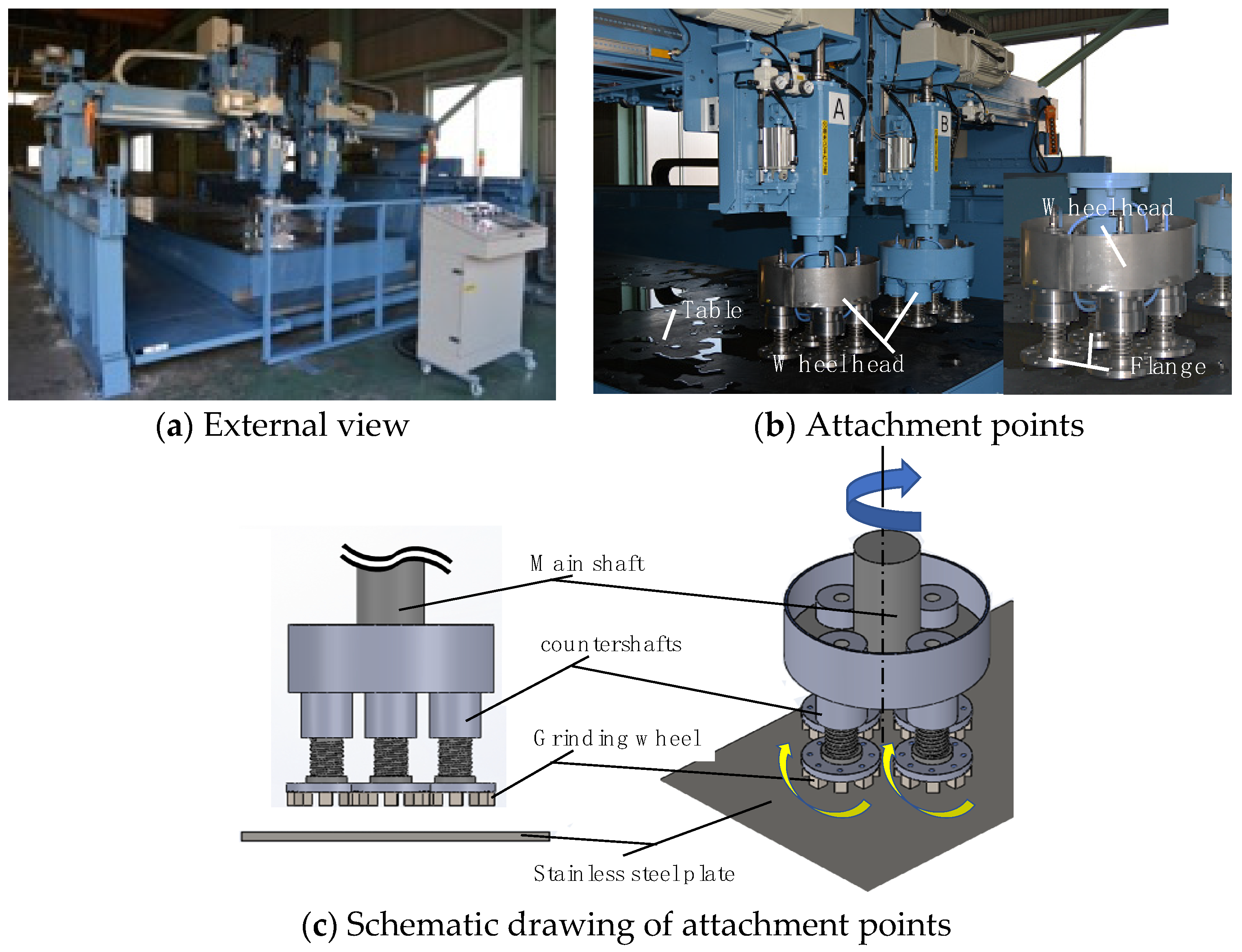







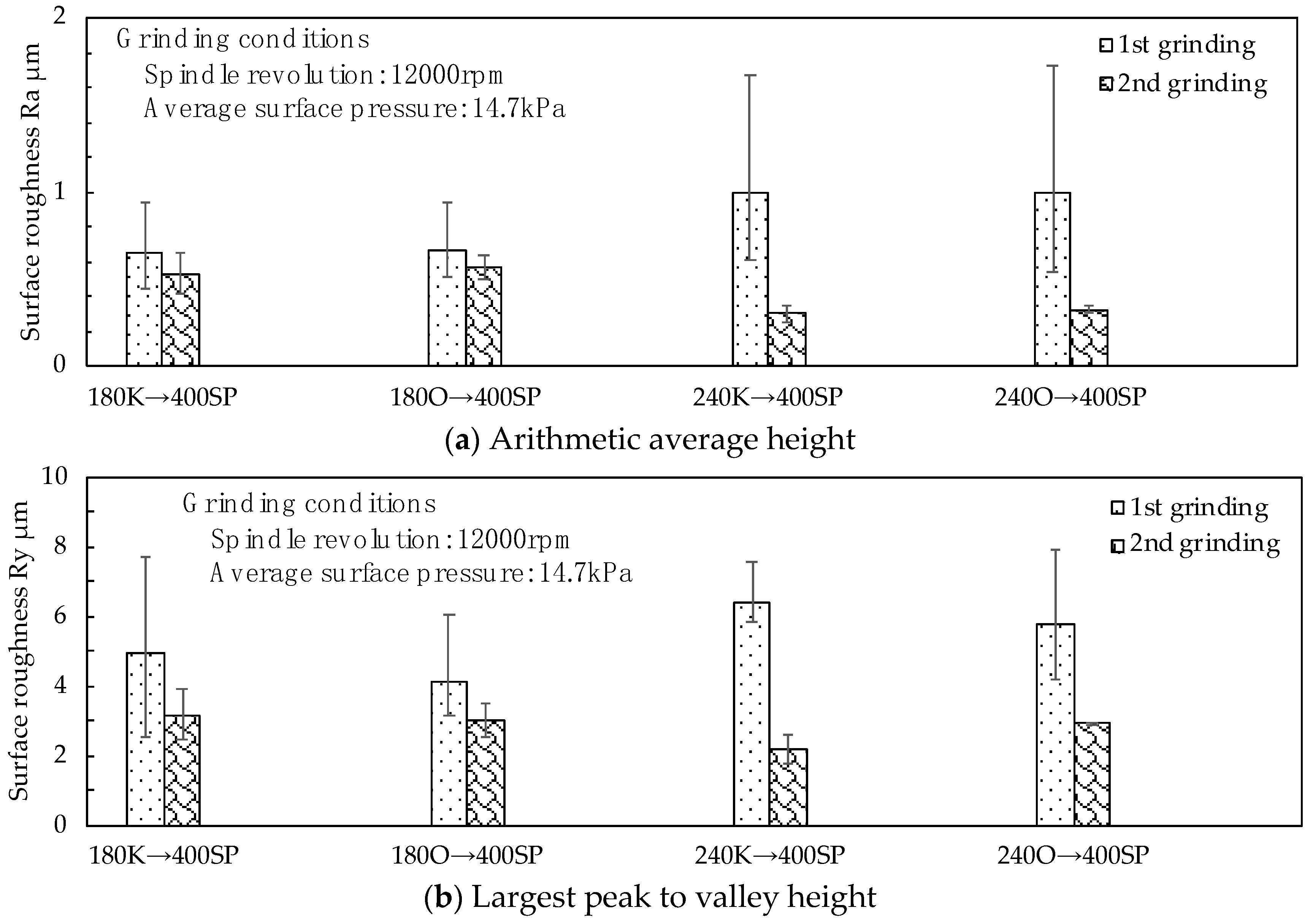
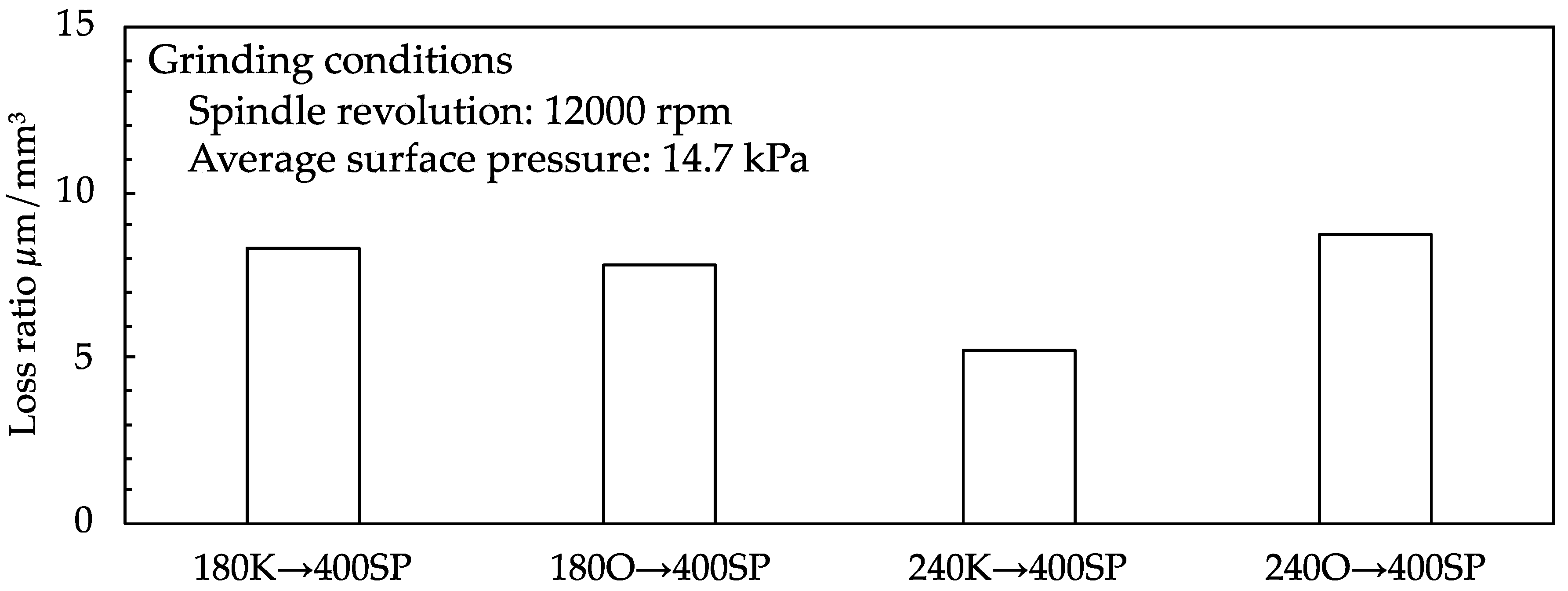
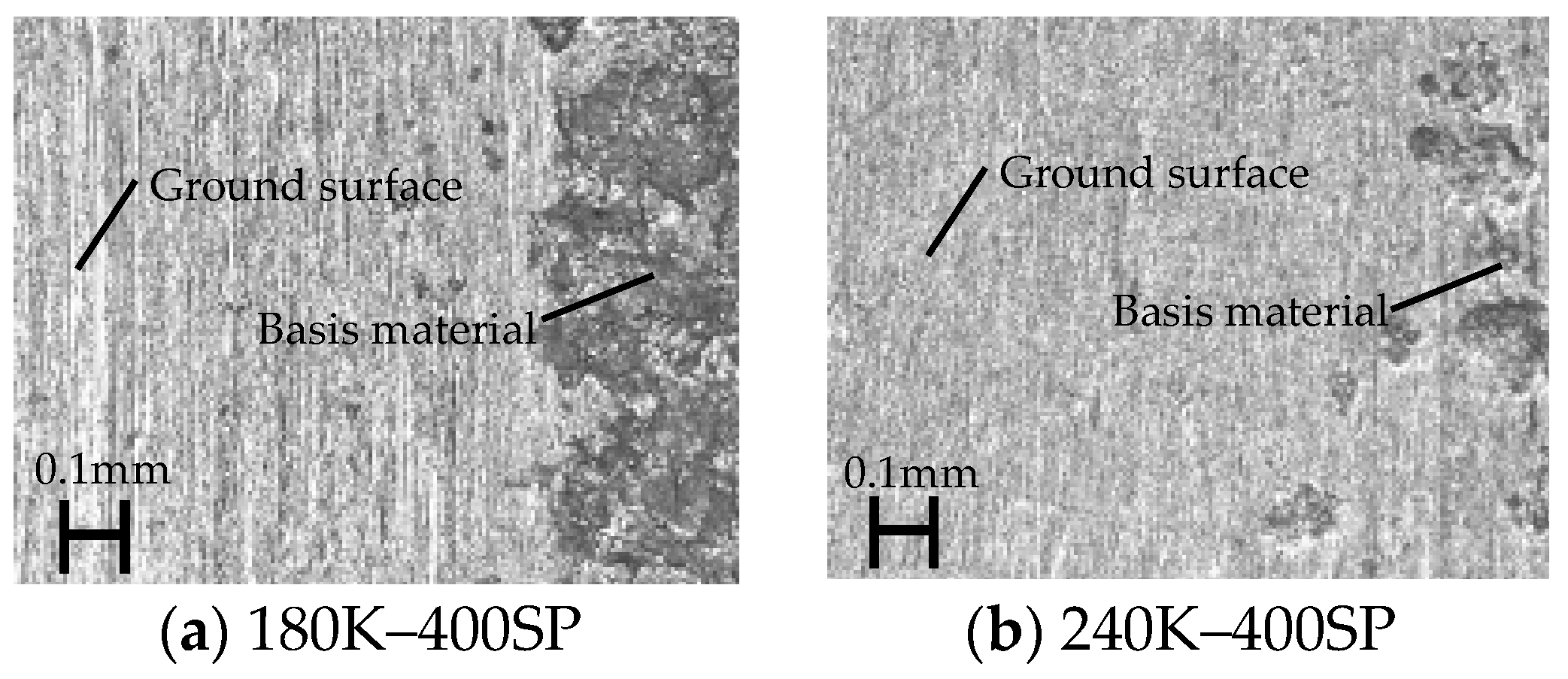
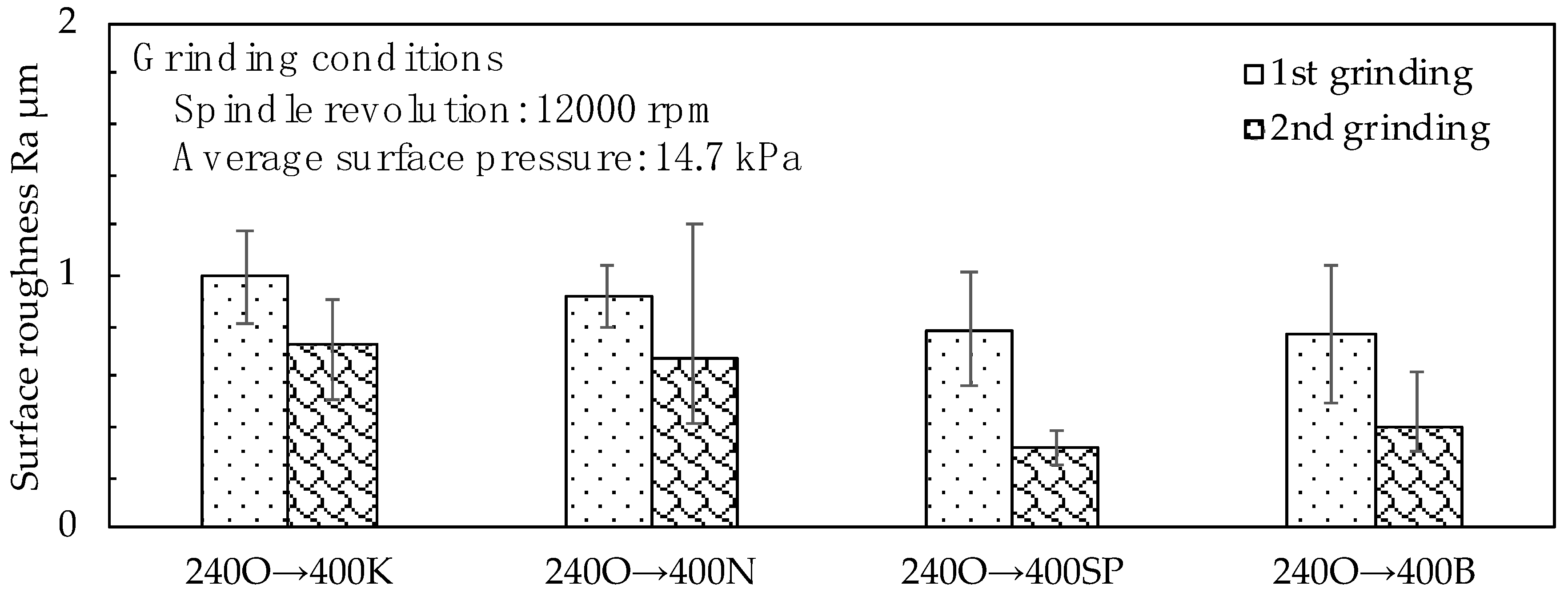
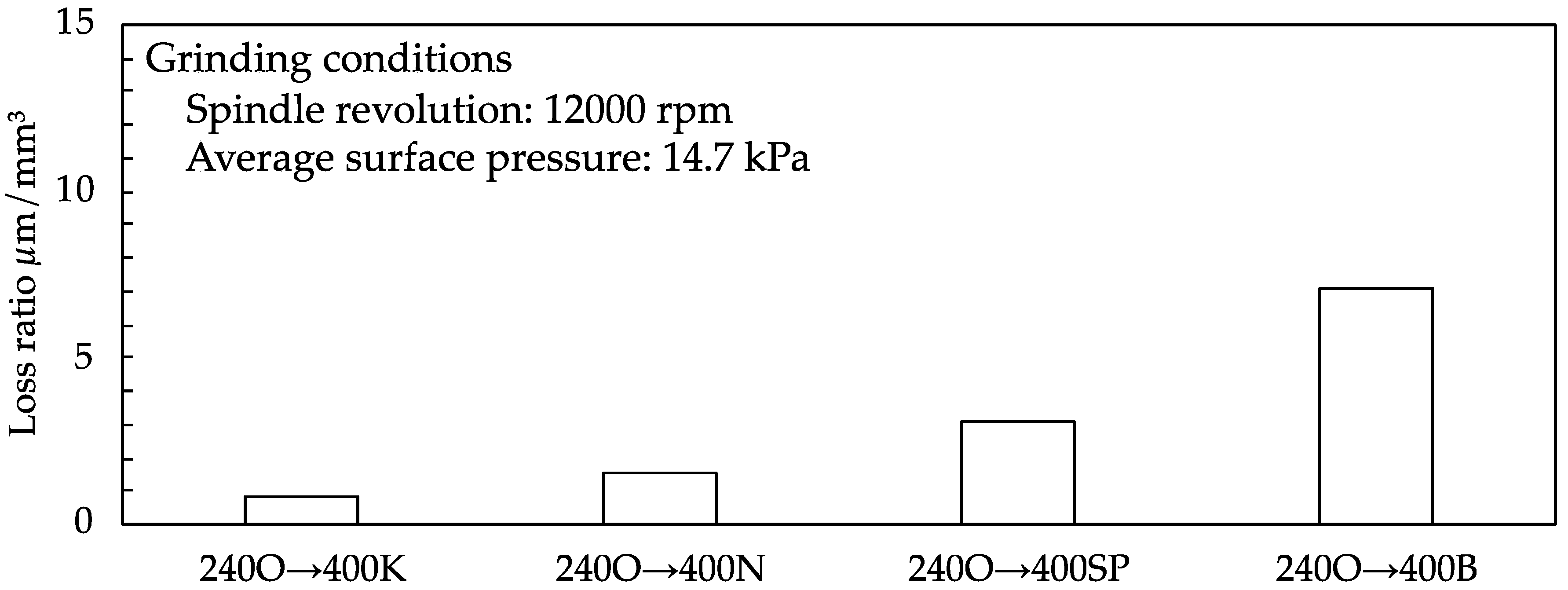
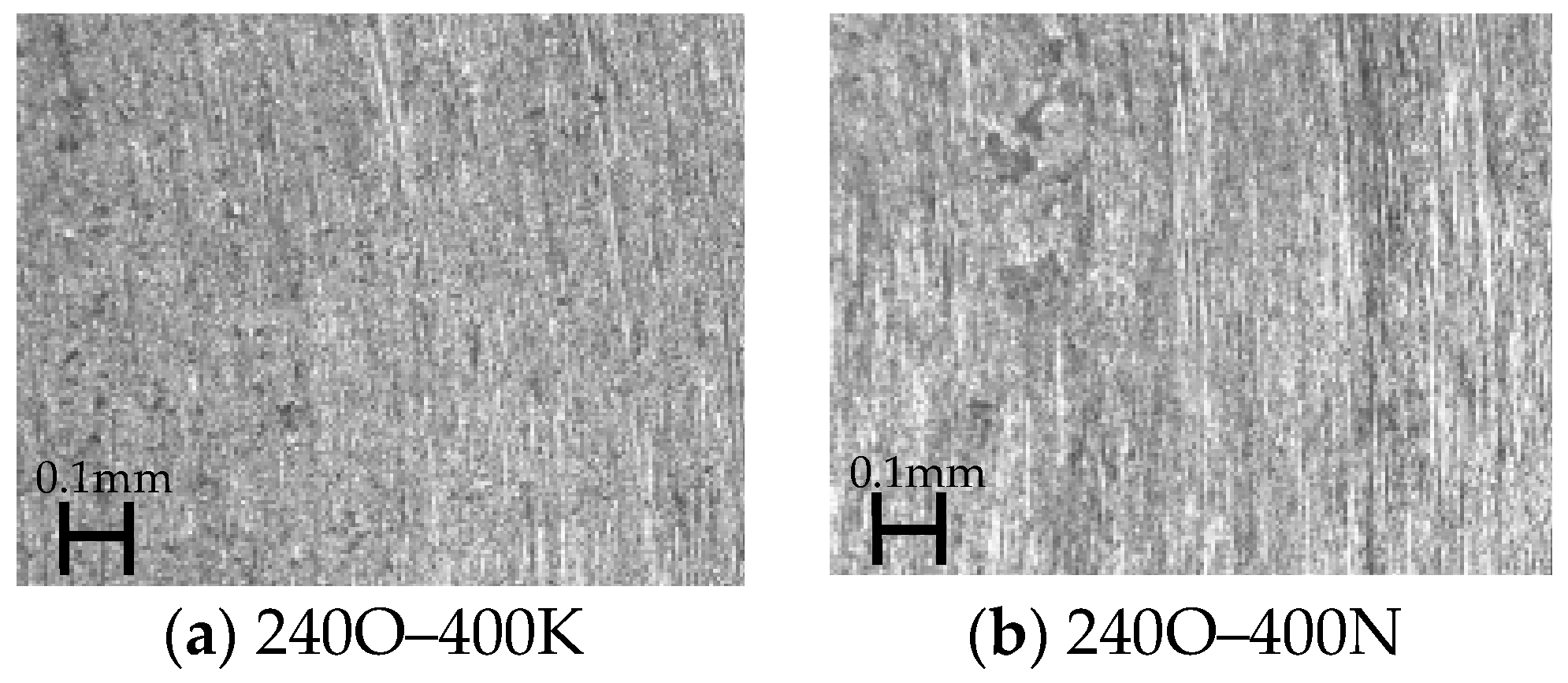
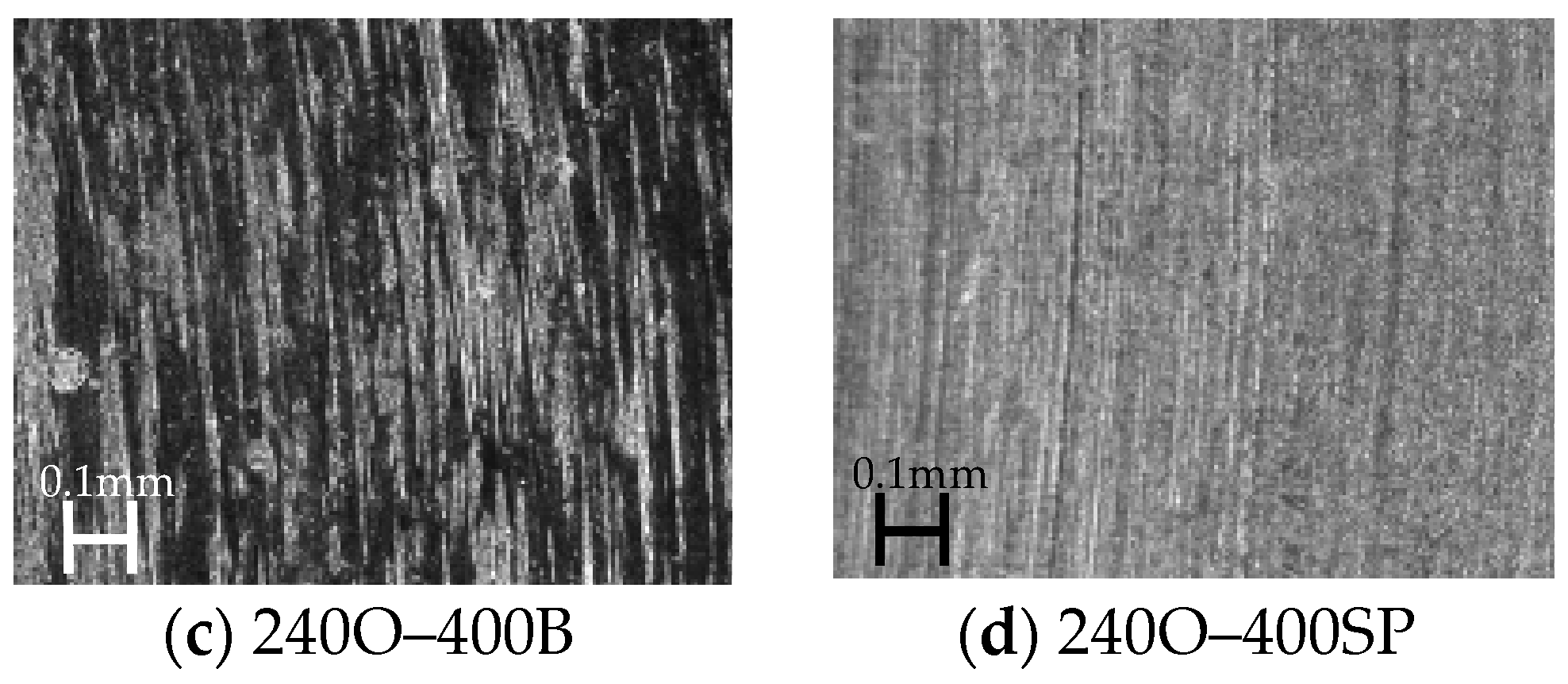
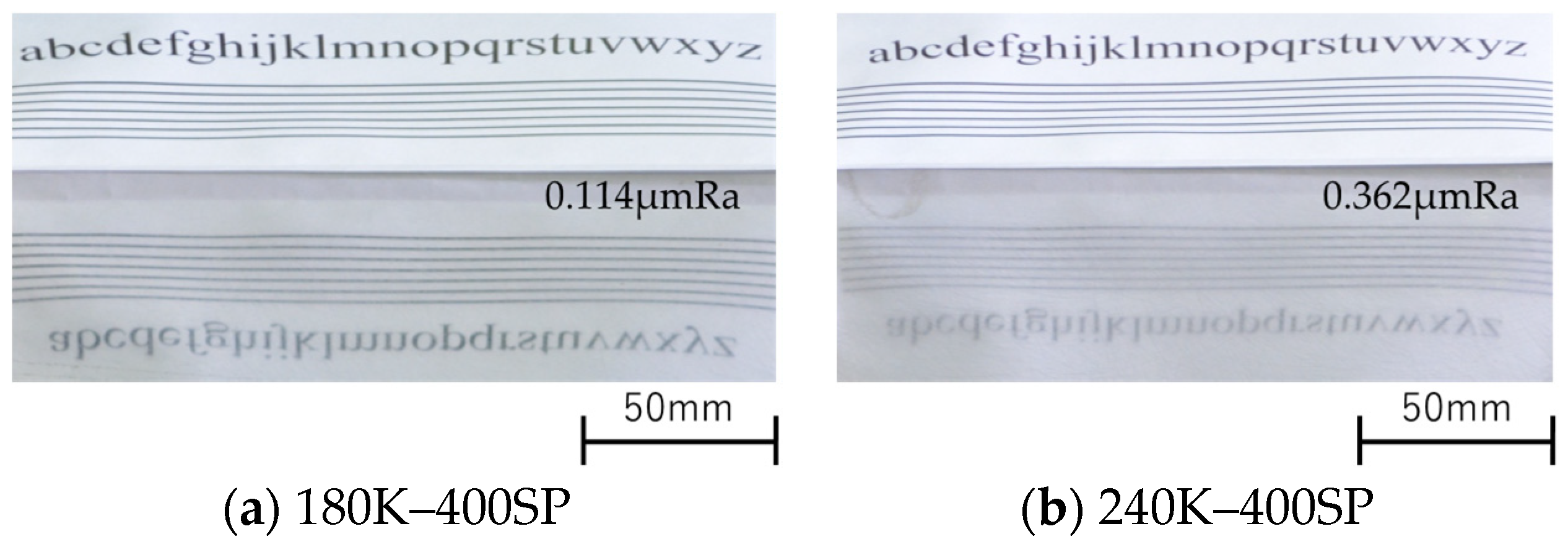

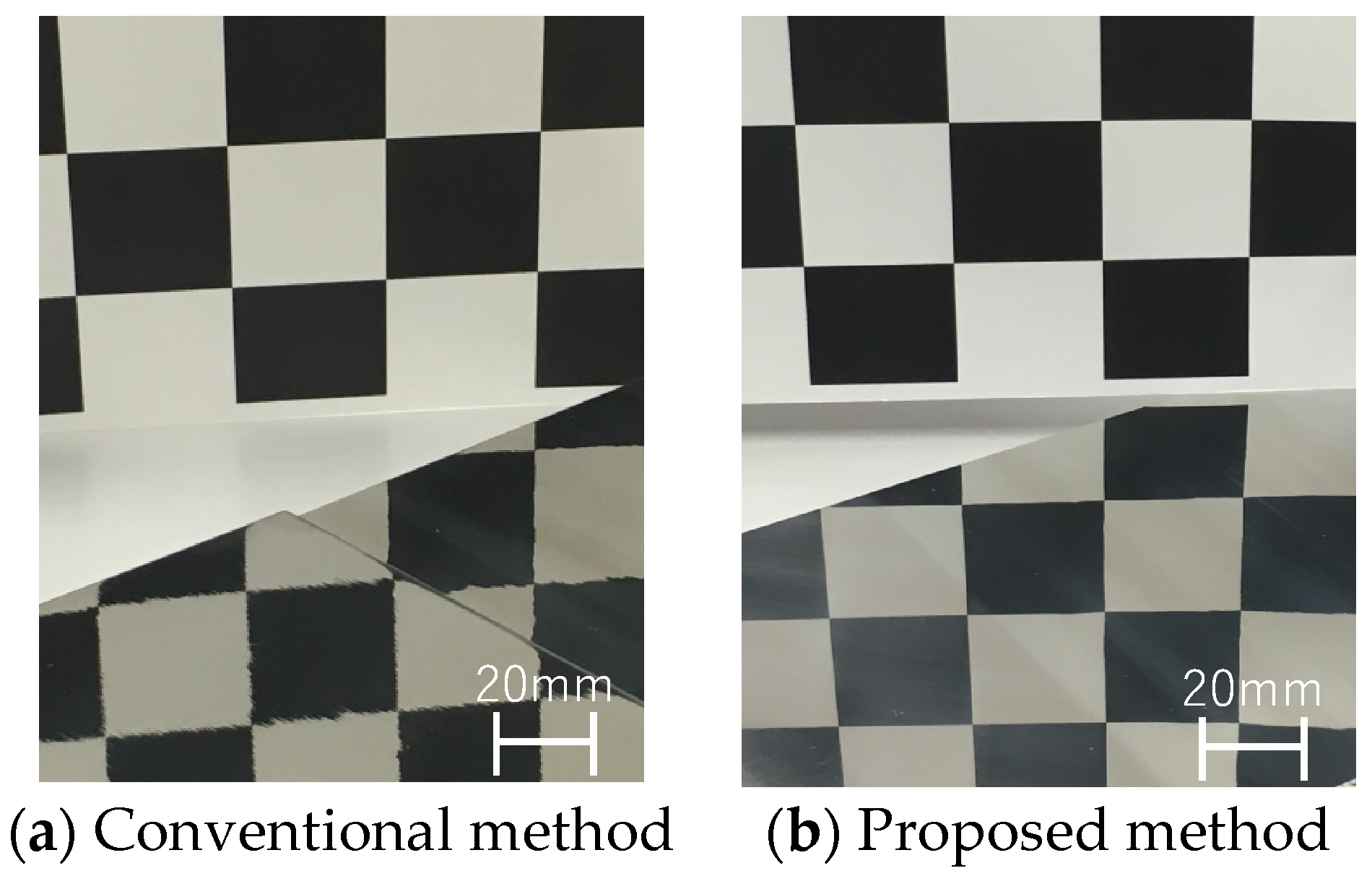
| Label | Grain Size | Bond | Grade |
|---|---|---|---|
| 180G | #180 | Vitrified | G |
| 180H | #180 | Vitrified | H |
| 180J | #180 | Vitrified | J |
| 180K | #180 | Vitrified | K |
| 180O | #180 | Vitrified | O |
| 240K | #240 | Vitrified | K |
| 240O | #240 | Vitrified | O |
| 400G | #400 | Vitrified | G |
| 400H | #400 | Vitrified | H |
| 400K | #400 | Vitrified | K |
| 400N | #400 | Vitrified | N |
| 400SP | #400 | Sponge | - |
| 400B | #400 | Resinoid | D |
Publisher’s Note: MDPI stays neutral with regard to jurisdictional claims in published maps and institutional affiliations. |
© 2020 by the authors. Licensee MDPI, Basel, Switzerland. This article is an open access article distributed under the terms and conditions of the Creative Commons Attribution (CC BY) license (http://creativecommons.org/licenses/by/4.0/).
Share and Cite
Mizobuchi, A.; Tashima, A. Optimization of Wet Grinding Conditions of Sheets Made of Stainless Steel. J. Manuf. Mater. Process. 2020, 4, 114. https://doi.org/10.3390/jmmp4040114
Mizobuchi A, Tashima A. Optimization of Wet Grinding Conditions of Sheets Made of Stainless Steel. Journal of Manufacturing and Materials Processing. 2020; 4(4):114. https://doi.org/10.3390/jmmp4040114
Chicago/Turabian StyleMizobuchi, Akira, and Atsuyoshi Tashima. 2020. "Optimization of Wet Grinding Conditions of Sheets Made of Stainless Steel" Journal of Manufacturing and Materials Processing 4, no. 4: 114. https://doi.org/10.3390/jmmp4040114
APA StyleMizobuchi, A., & Tashima, A. (2020). Optimization of Wet Grinding Conditions of Sheets Made of Stainless Steel. Journal of Manufacturing and Materials Processing, 4(4), 114. https://doi.org/10.3390/jmmp4040114





